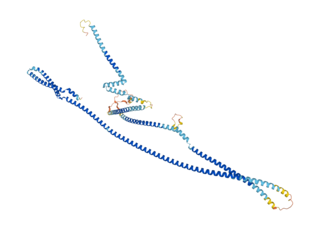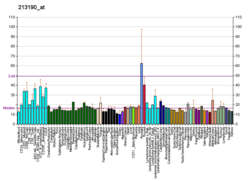
ADP-ribosylation factor 1 is a protein that in humans is encoded by the ARF1 gene.

Coatomer subunit beta is a protein that in humans is encoded by the COPB1 gene.

Cux1 is a homeodomain protein that in humans is encoded by the CUX1 gene.

Alpha-centractin (yeast) or ARP1 is a protein that in humans is encoded by the ACTR1A gene.

COP9 signalosome complex subunit 4 is a protein that in humans is encoded by the COPS4 gene.

Protein transport protein Sec61 subunit beta is a protein that in humans is encoded by the SEC61B gene.

Coatomer subunit gamma is a protein that in humans is encoded by the COPG gene. It is one of seven proteins in the COPI coatomer complex that coats vesicles as they bud from the Golgi complex.

Golgin subfamily A member 3 is a protein that in humans is encoded by the GOLGA3 gene.

5'-AMP-activated protein kinase subunit beta-2 is an enzyme that in humans is encoded by the PRKAB2 gene.

AP-1 complex subunit gamma-like 2 is a protein that in humans is encoded by the AP1G2 gene.

Conserved oligomeric Golgi complex subunit 3 is a protein that in humans is encoded by the COG3 gene.

AP-3 complex subunit sigma-2 is a protein that in humans is encoded by the AP3S2 gene.

N-terminal acetyltransferase B complex catalytic subunit NAT5 is an enzyme that in humans is encoded by the NAT5 gene.

Conserved oligomeric Golgi complex subunit 4 is a protein that in humans is encoded by the COG4 gene.

RAD50-interacting protein 1 is a protein that in humans is encoded by the RINT1 gene.

Conserved oligomeric Golgi complex subunit 8 is a protein that in humans is encoded by the COG8 gene.

Conserved oligomeric Golgi complex subunit 5 is a protein that in humans is encoded by the COG5 gene.

Conserved oligomeric Golgi complex subunit 1 is a protein that in humans is encoded by the COG1 gene.

Conserved oligomeric Golgi complex subunit 2 is a protein that in humans is encoded by the COG2 gene. Multiprotein complexes are key determinants of Golgi apparatus structure and its capacity for intracellular transport and glycoprotein modification. Several complexes have been identified, including the Golgi transport complex (GTC), the LDLC complex, which is involved in glycosylation reactions, and the SEC34 complex, which is involved in vesicular transport. These 3 complexes are identical and have been termed the conserved oligomeric Golgi (COG) complex, which includes COG2.

Caveolin-2 is a protein that in humans is encoded by the CAV2 gene.





















